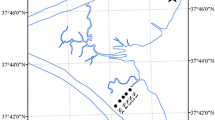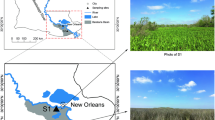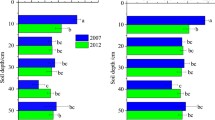Abstract
Purpose
Climate warming and sea level rise have the potential to change the salt level of soil in tidal wetlands. And it is important to clarify the process and the mechanism of decomposition of soil organic carbon in a tidal wetland under varying salinities. The aim of this study was to evaluate the impacts of soil salinity on the decomposition rate of organic carbon (DROC) and dissolved organic carbon (DOC) in a tidal wetland.
Materials and methods
Two types of soil (surface soil in Suaeda salsa and bare tidal flat) were collected, air-dried, and homogenized. After adding different content of salt (0 g/L, 3 g/L, 6 g/L, 9 g/L, and 12 g/L), the soils were incubated for 28 days at stable room temperature (25 ± 2 °C) and added by deionized water to maintain the stability of soil moisture. The gases (CO2 and CH4) emission rates of each salt treatment were measured during 28-day incubation. DROC was determined by the sum of daily CO2-C emission rates and daily CH4-C emission rates in this study.
Results and discussion
Salt addition inhibited the process of gas emissions and DROC. Gases emission rates and DROC of two types of soil showed similar temporal trends, with distinctive drop in the beginning of experiment and no significant decrease followed. Significant difference of DOC among salt treatments was found in the bare tidal flat soil. Variations of partial correlation between DROC and soil salinity and DOC showed similar trends (e.g., in days 9–18, the positive effect of DOC on DROC was greatly promoted (R2 = 0.80, p < 0.001), and the negative effect of soil salinity was highly improved (R2 = 0.93, p < 0.001)). Soil properties, in particular DOC, may be primary factors accounting for the discrepancy of gases emission rates and DROC of two types of soil.
Conclusions
Increased soil salinity had a negative effect on DROC during 28-day incubation. The impact of soil salinity and DOC on DROC were varied in different phases of laboratory experiment (soil salinity generally had increasingly negative relationship with DROC, but DOC showed most significantly positive relationship in the middle stage of incubation). Both the formation and consumption of DOC may be valuable for more detail research regarding to decomposition of soil organic carbon.




Similar content being viewed by others
References
Ardon M, Helton AM, Bernhardt ES (2016) Drought and saltwater incursion synergistically reduce dissolved organic carbon export from coastal freshwater wetlands. Biogeochemistry 127(2–3):411–426
Bai JH, Lu QQ, Zhao QQ, Wang J, Gao Z, Zhang G et al (2015) Organochlorine pesticides (OCPs) in wetland soils under different land uses along a 100-year chronosequence of reclamation in a Chinese estuary. Sci Rep 5:17624
Bai JH, Ye XF, Jia J, Zhang G, Zhao Q, Cui B, Liu X et al (2017) Phosphorus sorption-desorption and effects of temperature, pH and salinity on phosphorus sorption in marsh soils from coastal wetlands with different flooding conditions. Chemosphere 188:677–688
Baldwin DS, Rees GN, Mitchell AM, Watson G, Williams J et al (2006) The short-term effects of salinization on anaerobic nutrient cycling and microbial community structure in sediment from a freshwater wetland. Wetlands 26(2):455–464
Bonneville MC, Strachan IB, Humphreys ER, Roulet NT et al (2008) Net ecosystem CO2 exchange in a temperate cattail marsh in relation to biophysical properties. Agr Forest Meteorol 148(1):69–81
Bramley H, Hutson J, Tyerman SD (2003) Floodwater infiltration through root channels on a sodic clay floodplain and the influence on a local tree species Eucalyptus largiflorens. Plant Soil 253(1):275–286
Chambers LG, Reddy KR, Osborne TZ (2011) Short-term response of carbon cycling to salinity pulses in a freshwater wetland. Soil Sci Soc Am J 75(5):2000–2007
Cheng CH, Lehmann J, Thies JE, Burton SD et al (2008) Stability of black carbon in soils across a climatic gradient. J Geophys Res-Biogeo 113(G2)
Chow AT, Tanji KK, Gao SD, Dahlgren RA et al (2006) Temperature, water content and wet-dry cycle effects on DOC production and carbon mineralization in agricultural peat soils. Soil Biol Biochem 38(3):477–488
Chowdhury N, Marschner P, Burns R (2011) Response of microbial activity and community structure to decreasing soil osmotic and matric potential. Plant Soil 344(1–2):241–254
Cook BD, Allan DL (1992) Dissolved organic carbon in old filed soils-compositional changes during the biodegradation of soil organic matter. Soil Biol Biochem 24(6):595–600
Erwin KL (2009) Wetlands and global climate change: the role of wetland restoration in a changing world. Wetl Ecol Manag 17(1):71–84
Fan X, Pedroli B, Liu G, Liu Q, Liu H, Shu L et al (2012) Soil salinity development in the yellow river delta in relation to groundwater dynamics. Land Degrad Dev 23(2):175–189
Guan B, Yu JB, Hou AX, Han G, Wang G, Qu F, **a J, Wang X et al (2017) The ecological adaptability of Phragmites australis to interactive effects of water level and salt stress in the Yellow River Delta. Aquat Ecol 51(1):107–116
Han GX (2017) Effect of tidal action and drying-wetting cycles on carbon exchange in a salt marsh: progress and prospects. Actaecologica sinica 37(24) (in Chinese)
Han GX, Chu XJ, **ng QH, Li D, Yu J, Luo Y, Wang G, Mao P, Rafique R et al (2015) Effects of episodic flooding on the net ecosystem CO2 exchange of a supratidal wetland in the Yellow River Delta. J Geophys Res-Biogeo 120(8):1506–1520
Kirwan ML, Mudd SM (2012) Response of salt-marsh carbon accumulation to climate change. Nature 489:550–553
Liu XJ, Ruecker A, Song B, **ng J, Conner WH, Chow AT et al (2017) Effects of salinity and wet-dry treatments on C and N dynamics in coastal-forested wetland soils: implications of sea level rise. Soil Biol Biochem 112:56–67
Lucas KL, Carter GA (2013) Change in distribution and composition of vegetated habitats on Horn Island, Mississippi, northern Gulf of Mexico, in the initial five years following hurricane Katrina. Geomorphology 199:129–137
Marton JM, Herbert ER, Craft CB (2012) Effects of salinity on denitrification and greenhouse gas production from laboratory-incubated tidal forest soils. Wetlands 32(2):347–357
Maucieri C, Zhang Y, McDaniel MD et al (2017) Short-term effects of biochar and salinity on soil greenhouse gas emissions from a semi-arid Australian soil after re-wetting. Geoderma 307:267–276
McDaniel MD, Simpson RR, Malone BP et al (2017) Quantifying and predicting spatio-temporal variability of soil CH4 and N2O fluxes from a seemingly homogeneous Australian agricultural field. Agr Ecosyst Environ 240:182–193
McLeod E, Chmura GL, Bouillon S et al (2011) A blueprint for blue carbon: toward an improved understanding of the role of vegetated coastal habitats in sequestering CO2. Front Ecol Environ 9(10):552–560
Metternicht GI, Zinck JA (2003) Remote sensing of soil salinity: potentials and constraints. Remote Sens Environ 85(1):1–20
Moore TR, Dalva M (2001) Some controls on the release of dissolved organic carbon by plant tissues and soils. Soil Sci 166(1):38–47
Nathaniel B, Weston MA, Vile SC et al (2011) Accelerated microbial organic matter mineralizationfollowing salt-water intrusion into tidal freshwater marsh soils. Biogeochemistry 102:135–151
Nellemann C, Corcoran E, Duarte CM et al (2009) Blue Carbon. A Rapid Response Assessment. GRID-Arendal: United Nations Environment Programme. ISBN: 978-82-7701-060-1
Osland MJ, Enwright NM, Day RH, Gabler CA, Stagg CL, Grace JB et al (2016) Beyond just sea-level rise: considering macroclimatic drivers within coastal wetland vulnerability assessments to climate change. Glob Change Biol 22(1):1–11
Rath KM, Rousk J (2015) Salt effects on the soil microbial decomposer community and their role in organic carbon cycling: a review. Soil Biol Biochem 81:108–123
Sangiorgio F, Basset A, Pinna M, Sabetta L, Abbiati M, Ponti M, Minocci M, Orfanidis S, Nicolaidou A, Moncheva S, Trayanova A, Georgescu L, Dragan S, Beqiraj S, Koutsoubas D, Evagelopoulos A, Reizopoulou S et al (2008) Environmental factors affecting Phragmites australis litter decomposition in Mediterranean and Black Sea transitional waters. Aquat Conserv 18:S16–S26
Setia R, Gottschalk P, Smith P, Marschner P, Baldock J, Setia D, Smith J et al (2013) Soil salinity decreases global soil organic carbon stocks. Sci Total Environ 465:267–272
Valzano FP, Greene RSB, Murphy BW, Rengasamy P, Jarwal SD et al (2001) Effects of gypsum and stubble retention on the chemical and physical properties of a sodic grey Vertosol in western Victoria. Aust J Soil Res 39(6):1333–1347
Wang JJ, Bai JH, Zhao QQ, Lu Q, **a Z et al (2016) Five-year changes in soil organic carbon and total nitrogen in coastal wetlands affected by flow-sediment regulation in a Chinese delta. Sci Rep 6:21137
Wong VNL, Dalal RC, Greene RSB (2008) Salinity and sodicity effects on respiration and microbial biomass of soil. Biol Fert Soils 44(7):943–953
Wong VNL, Dalal RC, Greene RSB (2009) Carbon dynamics of sodic and saline soils following gypsum and organic material additions: a laboratory incubation. Appl Soil Ecol 41(1):29–40
Wong VNL, Greene RSB, Dalal RC, Murphy BW et al (2010) Soil carbon dynamics in saline and sodic soils: a review. Soil Use Manage 26(1):2–11
Yu JB, Li YZ, Han GX et al (2014) The spatial distribution characteristics of soil salinity in coastal zone of the Yellow River Delta. Environ Earth Sci 72(2):589–599
Zhang JB, Song CC, Wang SM (2007a) Dynamics of soil organic carbon and its fractions after abandonment of cultivated wetlands in Northeast China. Soil Till Res 96:350–360
Zhang LB, Xu HL, Zhao GX (2007b) Salt tolerance of Suaeda salsa and its soil ameliorating effect on coastal saline soil. Soils 39:310–313 (in Chinese)
Zhang H, Chen XB, Luo YM (2016) An overview of ecohydrology of the Yellow River delta wetland. Ecohydrol Hydrobiol 16:39–44
Zhang GL, Bai JH, Jia J, Wang X, Wang W, Zhao Q, Zhang S et al (2018) Soil organic carbon contents and stocks in coastal salt marshes with Spartina alterniflora following an invasion chronosequence in the Yellow River Delta, China. Chin Geogr Sci 28(3):374–385
Zhao QQ, Bai JH, Lu QQ, Zhang G et al (2017) Effects of salinity on dynamics of soil carbon in degraded coastal wetlands: implications on wetland restoration. Phys Chem Earth, Parts A/B/C 97:12–18
Zhao QQ, Bai JH, Zhang GL, Jia J, Wang W, Wang X et al (2018) Effects of water and salinity regulation measures on soil carbon sequestration in coastal wetlands of the Yellow River Delta. Geoderma 319:219–229
Zimmerman AR, Gao B, Ahn MY (2011) Positive and negative carbon mineralization priming effects among a variety of biochar-amended soils. Soil Biol Biochem 43(6):1169–1179
Acknowledgements
We are grateful for the support from Yellow River Delta Ecological Research Station of Coastal Wetland, CAS, and also thank two anonymous reviewers for their expert advice and fruitful comments.
Funding
This research was funded by the National Nature Science Foundation of China (41671089), the Science and Technology Service Network Initiative (KFJ-STS-ZDTP-023), and Key deployment project of Chinese Academy of Sciences (KFZD-SW-112).
Author information
Authors and Affiliations
Corresponding author
Additional information
Responsible editor: Shiming Ding
Rights and permissions
About this article
Cite this article
Qu, W., Li, J., Han, G. et al. Effect of salinity on the decomposition of soil organic carbon in a tidal wetland. J Soils Sediments 19, 609–617 (2019). https://doi.org/10.1007/s11368-018-2096-y
Received:
Accepted:
Published:
Issue Date:
DOI: https://doi.org/10.1007/s11368-018-2096-y




